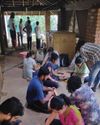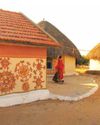
It shares light-hearted anecdotes and playful illustrations from the five years of architectural college education; while navigating through life and growing emotionally and professionally as a young adult; from entering wide-eyed into a design studio to working through the highs and lows of the degree to finally surmounting the final thesis year and coming out as an architect. Building new relationships with friends, family, the society, self and most-importantly with architecture is a key theme within the book. A relationship that is brimming with passion, angst and awe. In the creative community of architecture and design, this book is the first of its kind that addresses mental wellness and self-care.
While a detailed account of life in architecture college, it stays relevant to professionals too as it appeals to the adolescent search for self. It urges students to soul-search, discover their purpose in life and ultimately find their space in the sea of opportunities that lie ahead.
The book released on 28th August 2019 at Kamla Raheja Vidyanidhi Institute for Architecture, Mumbai followed by a discussion around multi-dimensional facets of teaching and learning. Following is an excerpt from the panel discussion at the launch, with Vandana Ranjitsinh, Rohan Shivkumar, Nisha Nair-Gupta and Suha Riyaz Khopatkar; moderated by Anuj Daga.
This story is from the November 2019 edition of Indian Architect & Builder.
Start your 7-day Magzter GOLD free trial to access thousands of curated premium stories, and 8,500+ magazines and newspapers.
Already a subscriber ? Sign In
This story is from the November 2019 edition of Indian Architect & Builder.
Start your 7-day Magzter GOLD free trial to access thousands of curated premium stories, and 8,500+ magazines and newspapers.
Already a subscriber? Sign In

Interlacing Perspectives
‘Meraki-2019’ A visionary Seminar series presented by Dr.Baliram Hiray College of Architecture, Bandra(East), Mumbai.

Facilitating A Community Through Architectural Practice
The humble, self-designed, self-built and organically planned home built by the majority of the world population rarely gets appreciated and critiqued as a viable lesson in architectural design.

The Art Of Solving Problems Creatively
The practice of architecture is perhaps incomplete without the complement of a variety of other arts.

Upcycling towards a playful tomorrow
Play is like the middle child, often forgotten, and always taking a back seat. For young kids, play can simply be running around, armwrestling with friends, building sandcastles on the beach, or singing popular music tracks in the shower.

Balancing The Poetics And Pragmatism Of Everyday Design
Humanity is faced with an oxymoronic crisis. The crisis involves the earth, the environment, impending looms of climate change, deforestation, loss of species, dwindling resources etc.

Just Give Me Some Space: Discussions And Beyond
Just Give Me Some Space (JGMSS) is Suha Riyaz Khopatkar’s debut book that paints a portrait of the dynamic life of an architecture student.

The Next In Vernacular Architecture
Architecture has become a capitalist.

Rethinking The Future: Architecture And Its Education
“I want to be like animals, the bird makes a nest in one or two days, the rat digs a hole in a night, but intelligent humans like us spend 30 years to have a house, that’s wrong.” - Jon Jandai

Uniting The Human-Scale With The City-Scale
London-based architect Usman Haque is famed for his interactive architectural systems, and for his exploration of newer, more effective ways of creating human engagement and interaction through his designs. Indian Architect & Builder caught up with him, to quiz him on a variety of topics such as his journey as an architect, his inspirations and philosophies, architects using the digital revolution to their advantage, and more!

Framing spaces
Almost every architect also doubles as a photographer or at least an enthusiast.